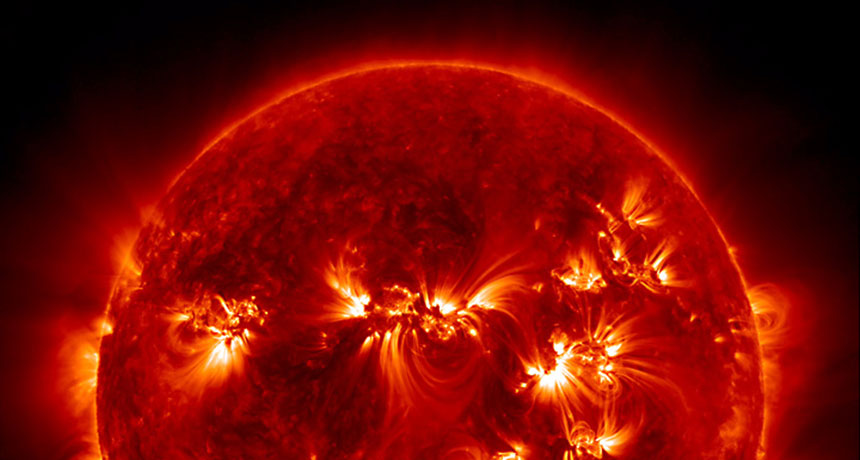An active sun is a somewhat smaller sun
The sun shrinks and grows a tiny bit over cycles lasting about 11 years

The radius of the sun gets a smidge smaller the sun is most active, a new study finds.
SOLAR DYNAMICS OBSERVATORY/NASA
How big is the sun? That depends on when you look, a new study finds.
Our home star shrinks slightly and expands again as it goes through a solar cycle. That’s a roughly 11-year period. It is characterized by times of high and low magnetic activity, changes in sunspot numbers and more. Two researchers now report finding that when the sun is most active, its radius drops by 1 or 2 kilometers (0.6 to 1.2 miles). That’s not much. The sun’s full radius is about 700,000 kilometers (435 million miles)!
Unlike many planets, the sun has no solid surface. That is one thing that makes computing the star’s size challenging. “It’s a slippery concept,” says Jeff Kuhn. “What does it mean, the radius of the sun?” asks this astronomer who works at the University of Hawaii in Maui. One way scientists have measured the orb’s width is based on how the brightness of the sun falls off from its center. In 2010, Kuhn’s group did that. That turned up no sign that the sun’s radius changed during the solar cycle.
The new study does something different. It measures what’s known as the sun’s seismic radius. Seismic waves travel through the sun’s interior. Any change in the sun’s size would change the frequency of those waves.
This new yardstick has some advantages, says Alexander Kosovichev. He’s an astrophysicist at the New Jersey Institute of Technology in Newark. “By using the seismic radius,” he says, “we can measure more accurately.” And that’s what he and Jean-Pierre Rozelot of Université Côte d’Azur in Nice, France, just did.
To figure out this seismic radius, the two used 21 years’ worth of data on the waves’ frequencies. Two spacecraft had collected those data. How much the sun expanded or shrunk varied by depth, those data show. Some layers within the sun contracted at the same time that others were expanding. Changes in the magnetic fields inside the sun could be behind the sun’s shifting size, the scientists say.
Taken together, the new data point to an overall drop in the seismic radius when the sun is more active.
This new estimate of the sun’s size is not, however, a replacement for measuring the radius in terms of overall brightness. “I think that’s a separate question,” Kuhn says. The two measurements rely on different techniques. They therefore probe different traits of the sun’s behavior.
The seismic radius may help scientists understand how the strength of the sun’s magnetic fields varies at different depths within the star, notes Sabatino Sofia. He’s a retired astrophysicist who used to work at Yale University in New Haven, Conn. There had been hints that the sun’s seismic radius might change over time. However, he says, the new data “really confirms that during the activity cycle, the seismic radius of the sun is changing.”
The paper by Kosovichev and Rozelot has been accepted to appear in an upcoming issue of The Astrophysical Journal.







